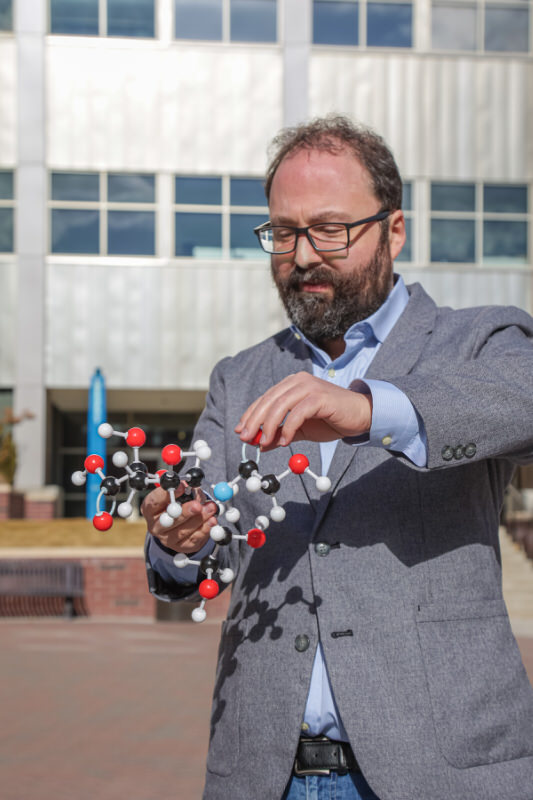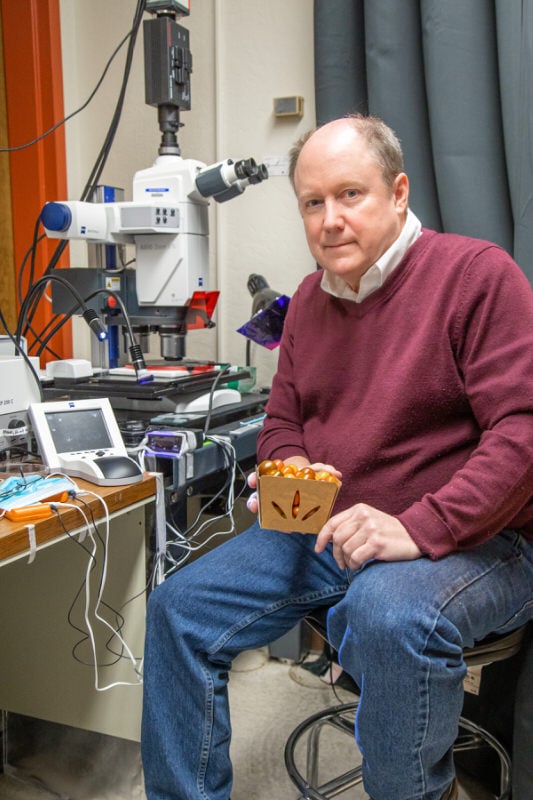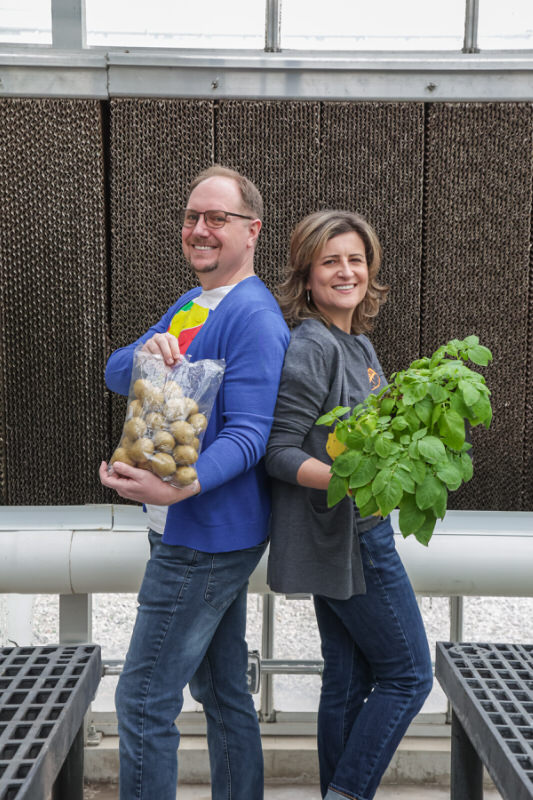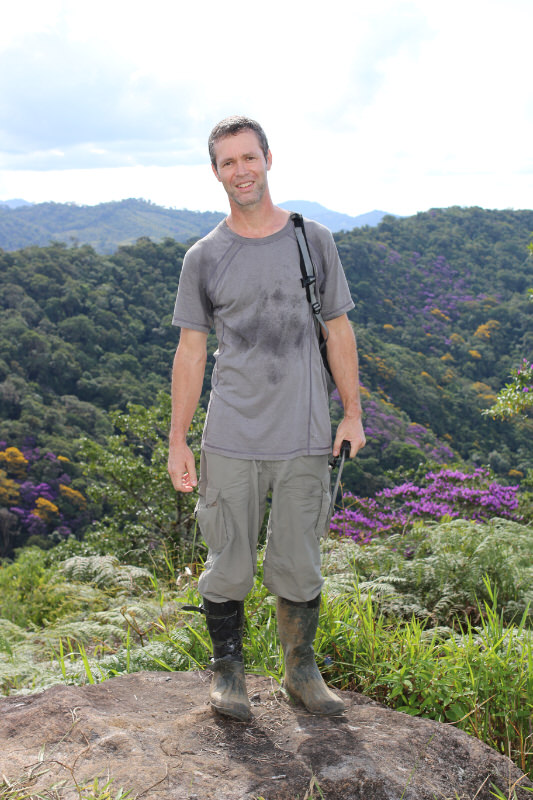How University of Nevada, Reno researchers are improving the way the world eats.
Scientific research is a realm of complexities, where finding answers often leads to more questions. Thanks to the considerable work of researchers who have accomplished significant milestones, such as mapping the human genome, recent scientific progress in the areas of health and agriculture has grown exponentially in just the past 10 years.
At the University of Nevada, Reno, a thriving, vibrantly diverse pool of scientific talent exists. Professors and their teams are conducting important research into issues that may positively affect not just regional residents, but the global population.
From discovering and saving species vital to agricultural health to helping combat childhood obesity, these researchers and their teams are helping humanity, right in our own backyard.
Protecting Biodiversity
Wasps may seem like pests to many people. But Lee Dyer, UNR professor and director of the university’s interdisciplinary Ecology, Evolution and Conservation Biology graduate program, knows otherwise. These “pests” actually are unsung heroes protecting crops.
While working in tropical environments, Dyer and his team found that parasitic wasps help protect banana plantations in or near rainforests by keeping other pest infestations low, versus growing the popular fruit in ecosystems that have been transformed for agricultural use. In these areas, more pest issues due to fewer parasitic wasps often translate to increased use of chemical pesticides.
Conducting research in areas that include the Great Basin, Costa Rica, and Ecuador provides Dyer and his team members access to poorly understood and understudied biodiversity. Their focus is on the origins, evolution, and maintenance of biodiversity as gauged by the number of interactions between the species, not the number of species. They specifically focus on chemistry and the role it plays in long-term diversity trends, such as why there are so many different kinds of plants and insects.
This approach demonstrates how stable an ecosystem is; higher species diversity equals ecological stability. For instance, if caterpillars or beetles eat part of a plant, that’s considered an interaction.
Having a diverse population of insects eating a plant lessens the probability of any of them inflicting ecologically relevant damage, such as a destructive crop outbreak. Competition is the name of the game — one species can’t get out of control when competing with many others for the resources. Also, some herbivores that feed on plants are good for the plants, boring into the stems and changing the plants’ chemistry so that other species can’t cause damage. Generalist predators such as parasitic wasps and flies also help keep other potentially harmful insects in check.
As Dyer explains, “There’s been a chemical arms race between plants and animals for millions of years,” over which time an enormous diversity of chemicals has developed that humans can learn from.
Dyer’s research also focuses heavily on the chemistry and compounds within plants. Studying the chemistry of plants has uncovered incredible diversity, and many compounds that have positive health impacts when ingested by humans, along with others that have uses in pharmaceuticals.
For example, Piper nigrum, otherwise known as black pepper, has antifungal and antibacterial compounds while also being rich in flavor for cooking. When studying the chemistry and not just the compounds, researchers can comprehend how they work and therefore synthesize elements that can act in the same positive ways.
This intersection between chemistry and biology prompted the opening of the Hitchcock Center for Chemical Ecology at UNR, which Dyer helped open in 2018.
Biodiversity is vital, and getting people to understand this can only help Dyer’s cause. He is ultimately propagating naturalists across the globe as part of his mission.
“When we lose this kind of biodiversity, we’re losing poetry, we’re losing amazing stories. Each one of these wasps, for example, has an incredible life history,” Dyer says. “This story that is nature … incredible dramas are actually happening … it’s part of the world that most people love.”
Genetics Improving the Way We Eat
About 2.5 million years ago, humans lost a genetic enzyme dubbed CMAH that was responsible for synthesizing a sugar known as Neu5Gc, which was found in many mammals consumed by people. Neu5Gc has been shown to produce inflammation and cancer in humans.
David Alvarez-Ponce, associate professor of bioinformatics in the UNR Department of Biology, and his team have been studying the evolution of genes and how they can be linked to nutritional applications.

While most mammals have the gene that can synthesize Neu5Gc, humans are an exception. Over the past several years and with research support, Alvarez-Ponce has mapped the genomes of hundreds of animal species to seek out which have Neu5Gc and which don’t. Those that do likely possess the sugar responsible for producing cancer in humans.
His research will help people select healthier foods to eat.
At some point, millions of years ago, the CMAH gene mutated and, through evolution, was deemed by our bodies as no longer useful. Other species lost it as well, including birds — which is why eating chicken has not been linked to cancer. As for seafood, researchers found that fish seem to only express Neu5Gc in eggs, so dining on caviar also may prove cancerous, while nibbling on the fish itself seems safe.
However, genetic mutations also lead to positive genetic diversity.
By applying computer technology to genetics, Alvarez-Ponce is identifying which animals and animal groups don’t have the gene in order to identify which food sources don’t produce cancer in humans.
Did humans evolve from being carnivorous beings to more omnivorous ones at some point? Alvarez-Ponce says that humans’ loss of the gene means that red meat and pork can give us cancer, but that through natural selection, human bodies would not have found high enough probability of cancer from red meat to justify retaining the gene.
His overarching goal is to understand the evolution of genes and genomes and how the sequences of DNA that correspond to the different genes are spared by natural selection. Today, more genomes are being mapped monthly, giving him and his researchers endless fodder for study.
Another application for these studies is to identify which species may be most viable for organ transplantation to humans. Organs from animals with Neu5Gc are rejected by the human body.
Alvarez-Ponce has managed to find practical applications for his work in a complex and ever-evolving field.
Just Add Dressing
Jeff Harper, foundation and regents professor in UNR’s Department of Biochemistry and Molecular Biology, sums up one of the challenges with science: “Poke in one direction and end up getting another problem.”
Harper has spent decades focusing on sustainable agriculture. He’s working on creating an entirely edible tomato plant that can provide sustenance even in space. Just add dressing for an instant salad.

Improving stress tolerance in plants is a major undertaking for him and his team. With climate change, it’s vital to learn to grow plants in any environment, from searingly hot to bitterly cold. They use genetic engineering to better understand plants and help improve their growth and environmental tolerance, with the long-term goal being that everyday gardeners could practically apply results.
Harper and his team have recently been studying pollination of plants, attempting to equip pollen cells with more antioxidants to improve plant health and propagation.
What they found was that oxidants, dangerous in high amounts, also are necessary as they provide a warning system for plants undergoing stress. Adding the extra antioxidants took away the ability of the cell to alert itself to stress. Equipping the pollen with too many antioxidants made it infertile.
So back to the drawing board with their newfound knowledge. Harper explains that nature is often far smarter than we crafty humans.
“We try something, we learn, then we try something a different way and start to get a better understanding of how the plant and cells work,” Harper says. “My contributions have been to the entire community. We know a lot of what we should not do and what will be dangerous, and by gaining all this knowledge, we can gain better understanding of what we should do, with better food-safety concerns in mind.”
Lowering Childhood Obesity Rates
According to the Centers for Disease Control and Prevention, childhood obesity affects about 13.7 million children and adolescents in the U.S.
Myriad health issues can be attributed to obesity, including type 2 diabetes, cardiovascular problems, joint and breathing issues, and so much more.
It’s become an issue of epidemic proportions — one that can be prevented.
One person trying to turn the tide toward better health in young people is Jamie Benedict, associate professor and UNR nutrition department chair.
With the help of USDA funding, Benedict and her crew of researchers, recipe testers, and developers have created a campaign aimed at reducing children’s intake of sugary beverages, considered one of the main factors in childhood obesity.
The Rethink Your Drink campaign provides resources such as recipe cards and information for families looking to give their children healthier, less-sugary beverages. Available in both Spanish and English, downloadable, printable recipes are made from low- or non-fat milk, fruit, herbal teas, and more, and are easily prepared in home kitchens with little ones.

“Our overall goal is to promote healthful beverages and to decrease sugary drink [consumption] among children,” Benedict says. “We employ many different approaches to accomplish this, including direct mail to households, print media, digital media (e.g. Facebook, digital newsletter, and a website), and partnerships with grocery stores, health care professionals, and schools.”
While food often is ingested in one sitting, beverages can be sipped over hours. Without providing the feeling of bulk in your stomach, sugary liquids such as juices, energy drinks, and sodas are easy to overindulge in.
During the past 10 to 15 years, Benedict explains, awareness about childhood obesity has been growing. Once the team, led by Benedict, investigated the issue, they gained “a growing realization that it [posed] a fairly significant health risk, and one we had a chance to modify.”
In a survey of physicians, 90 percent expressed concern about the childhood obesity epidemic. Rethink Your Drink resources were shared with doctors and dentists statewide in an effort to get them into concerned parents’ hands.
Grocery stores proffered recipe cards in eye-catching stands as well, helping to achieve Benedict’s goal of reaching as many families as possible. So far, 32,000 recipe cards have been distributed. Now, a booklet containing these resources and recipes and provided to SNAP recipients also has been published.

Drinks that are fun to create as a family such as the Tropical Fizz, made with sparkling water and fruit juice, and Banana Milk Spice, which blends bananas, low-fat milk, cinnamon, and vanilla, now are readily available at Rethinkyourdrinknevada.com.
Helping Global Food Insecurity, One Potato at a Time
Potatoes are the largest vegetable crop in the U.S. Annually, it’s an industry worth more than $4 billion. Yet about one-third of that crop is lost each year to disease spread during storage, resulting in about a $1.4 billion annual loss of revenue — not to mention the unfortunate food waste.
Thankfully, Dylan Kosma and Patricia Santos, a husband-and-wife research team in the UNR Biochemistry and Molecular Biology department, is working to solve this problem as well as address global food insecurity.
Santos, assistant professor of plant/microbe interactions, and Kosma, assistant professor of plant lipids, study a specific micro-molecule with an enormous impact on water loss and microbe attacks on plants. Santos specializes in plant microbe interactions while Kosma is on the biochemistry side. Together, they work at a fundamental level of plant science, but direct research toward applied outcomes to assist the agricultural industry, a primary focus for both of them.

Because nutrient-rich potatoes are harvested in fall and can be stored for up to 11 months, people can dine on them year round. Potatoes can survive such lengthy storage times due to a naturally occurring biopolymer called suberin.
When harvested by hand or mechanically, then transported to storage facilities, potatoes often get damaged. Plants, when wounded, have evolved extraordinary mechanisms for making their own bandages, distributing different biopolymers such as suberin to seal off their injuries. However, if microbes manage to get into one potato, they begin to feed on the heavy starches and multiply rapidly. The potato’s sugars start to degrade and it begins to rot, which can then infect others. Storage rot is the main reason a crop gets lost after being harvested.
Santos and Kosma are studying the molecular methods in which plants make and deposit these biopolymers, such as suberin, in response to wounding. Their work may help to lessen global food insecurity by helping to better store critical crops.
Why potatoes?
Because they’re a food staple around the world. Also scientists know every gene in the potato genome now, which has enabled research that couldn’t be done before. Kosma says genetic sequencing has “totally changed the face of plant research as we know it.”
“We’ve identified a number of genes that we think are master regulators or ‘switches’ that activate suberin production during plant wounding,” he explains.
The National Science Foundation concurs with the importance of their research. As a result of their first attempt at grant writing, Santos and Kosma received $1.4 million in funding from the NSF for their work.
This allowed them to bring in a diverse team — including researchers from both UNR and Michigan State University, where the duo first met — to study this multi-disciplinary issue.
Santos and Kosma have pulled together a full spectrum of experts in biofermentation, computational facets such as finding genes through algorithms, plant pathologies, and even a potato breeder.
Their noble mission is to improve crops for the real world; they hope their potato studies will translate to other crops as well, and that they can play an instrumental role in cultivating healthy, safely storable vegetable crops.
Each of these pioneering researchers happily calls the Great Basin home. With the help of their indispensable teams, the extraordinary headway they’re making in combatting global food insecurity and other critical issues may soon spill over to other continents — perhaps, eventually, even other planets.


